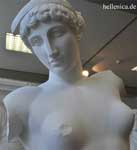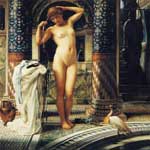The Esquiline Venus is a smaller-than-life-size Roman nude marble sculpture of a female in a sandal and headdress.


History
It was found in 1874 in Piazza Dante on the Esquiline Hill in Rome, probably part of the site of the Horti Lamiani,[2] one of the imperial gardens, rich archaeological sources of classical sculpture. In the 16th and 17th centuries, the thirteen Medici Niobids, a variant of the Laocoön and his Sons, the bust of Commodus with the attributes of Hercules, and the Discobolus had already been found here. After 1870 intensive building work was ongoing at the site to make Rome ready as Italy's capital, following the Risorgimento.[3] The newly found sculpture soon passed into the collection of the Capitoline Museums,[4] where it now resides, and is usually on display at its Museo Centrale Montemartini.[5]
In style the Esquiline Venus is an example of the Pasitelean "eclectic" Neo-Attic school, combining elements from a variety of other previous schools - a Praxitelean idea of the nude female form; a face, muscular torso, and small high breasts in the fifth-century BC severe style; and pressed-together thighs typical of Hellenistic sculptures.[6] Its arms must have broken off when the statue fell after the imperial park in which it stood fell into neglect after antiquity. They have been frequently restored in paintings (see below), but never in reality.
Subject
A Sculptor's Model, by Alma-Tadema, 1877
The statue's subject has variously been interpreted, as the Roman goddess Venus (possibly in the form Venus Anadyomene), as a nude mortal female bather, a female version of the diadumenos tying up the hair with a fillet (see below). Its provenance has been characterized both as a Ptolemaic commission or as a copy of one, perhaps a copy commissioned by Claudius himself for the imperial gardens.[7]
In modern art

"Diadumene", by Poynter
The sculpture inspired many artistic reconstructions in the decade after its discovery. Chief among these are Sir Lawrence Alma-Tadema's A Sculptor's Model (1877) and Edward Poynter's Diadumene (1884).[8] These both portrayed the statue's model binding her hair with a strip of fabric (as with the statue type diadumenos) in preparation for modelling for the sculptor or for taking a bath respectively. Poynter believed this to be the correct reconstruction partly because the remains of the little finger of her left hand are visible on the back of her head, suggesting that her left arm was raised to hold her hair in place, whilst the right hand wound the fabric. At the Museo Centrale Montemartini, the Esquiline Venus is now usually displayed behind a 'pool' (actually a glass floor panel) in tribute to this rendering.
Exhibitions
From December 2006 to February 4, 2007 the sculpture was the centrepiece of the exhibition "Cleopatra and the Caesars" at the Bucerius Kunst Forum at Hamburg,[9] following which, from March to June 2007, she was at the Louvre for the Praxiteles exhibition.
Notes
Later, 2nd century Parian marble torso of this type, from Brindisi [1]
"The identification is attractive, but not certain, according to Lawrence Richardson, A new Topographical Dictionary of Ancient Rome, s.v. "Horti Lamiani".
The Boxer of Quirinal was discovered in similar circumstances in 1885.
Accession number: inv. MC1141
Musei Capitolini: Museo Montemartini
Robinson: "the Esquiline Venus is an anomalous work, for while the body is modelled with a voluptuousness that almost oversteps the line dividing the nude from the naked, the head is treated with archaic severity, in the style of the first half of the fifth century", quoted in Edmund von Mach, A Handbook of Greek and Roman Sculpture 1905, plate 318 and p 348f.
This identification is based on the statue's Egyptian-style robe, descending over a vase, the asp on the vase, and curly hair; if correct, these features could make it a cult statue of Isis, or an image (perhaps that set up by Julius Caesar) of Cleopatra VII as Isis or Venus-Isis (the two were frequently conflated). This view is backed by the Italian philologist Licinio Glori in 1955. Or she could be a copy of the statue of Cleopatra set up by Caesar in the temple of Venus Genetrix, a view supported by Bernard Andreae. For bibliography on this point, see here.
Poynter worked from the cast of the original in the Sculpture Court of the Victoria and Albert Museum, according to the reviewer in Blackwood's Edinburgh Magazine, "The Decline of Art: the Royal Academy and Grosvenor Gallery", July 1885, in an extended justification of nudity in art: "Slightly, however, he has seen fit to modify the head: archaic curls are relaxed into flowing locks, and severe features relent into society smiles" (p. 13).
Bucerius Kunst Forum
References
Mary Beard, 'Archaeology and Collecting in late-nineteenth century Rome', from exhibition catalogue to the Royal Academy exhibition "Ancient Art to Post-Impressionism - Masterpieces from the Ny Carlsberg Glyptotek, Copenhagen"
Charles Waldstein, 'Pasiteles and Arkesilaos, the Venus Genetrix and the Venus of the Esquiline', The American Journal of Archaeology and of the History of the Fine Arts, Vol. 3, No. 1/2 (Jun., 1887), pp. 1–13
Cleopatra?
Das Gesicht der Göttin., 16.10.2006, Der Spiegel. Hamburg 2006, 42, S. 181
Berthold Seewald, So sah Kleopatra wirklich aus, Die Welt, 26 October 2006 (in German)[2]
Bernard Andreae, Dorothea Gall, Günter Grimm, Heinz Heinen et al., "Kleopatra und die Caesaren", hrsg. von Ortrud Westheider, Karsten Müller (2006: Munich, Hirmer Verlag)
Cleo Uncovered (exhibition review of "Cleopatra and the Caesars"), Current World Archaeology 20, pages 42–43
Retrieved from "http://en.wikipedia.org/"
All text is available under the terms of the GNU Free Documentation License
| Ancient Greece
Science, Technology , Medicine , Warfare, , Biographies , Life , Cities/Places/Maps , Arts , Literature , Philosophy ,Olympics, Mythology , History , Images Medieval Greece / Byzantine Empire Science, Technology, Arts, , Warfare , Literature, Biographies, Icons, History Modern Greece Cities, Islands, Regions, Fauna/Flora ,Biographies , History , Warfare, Science/Technology, Literature, Music , Arts , Film/Actors , Sport , Fashion --- |

